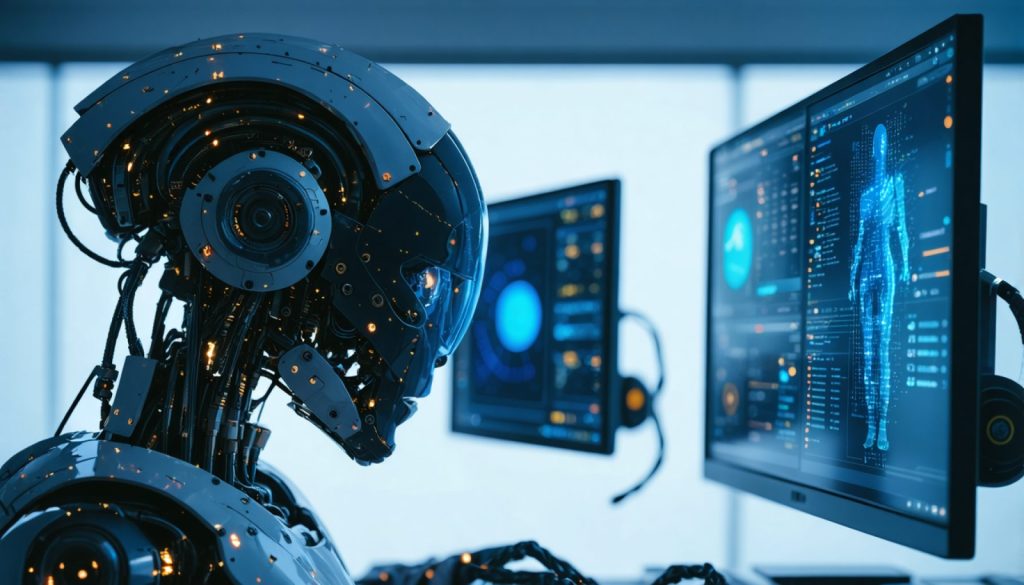
- Cybercriminals are exploiting AI to create sophisticated and deceptive threats, including the use of digital twins for fraud.
- Ransomware attacks have evolved to include data encryption and exfiltration, risking exposure of sensitive information across sectors like healthcare and education.
- AI-generated phishing emails and deepfake videos are increasingly convincing, bypassing traditional security measures.
- Poisons AI models with tainted datasets can spread harmful code, impacting widespread applications.
- Both Android and iOS platforms are vulnerable to banking malware and spyware, while cloud services expose further security risks.
- Proactive cybersecurity, leveraging AI for threat prediction and robust system management, is essential to counter evolving digital threats.
Imagine a world where your digital twin, a nearly perfect replica of your identity, roams the internet—created not for convenience, but to deceive and defraud. This isn’t the plot of a dystopian novel; it’s the current frontier in cybercrime. According to experts at Check Point Software, cybercriminals are not only evolving but thriving by harnessing the power of artificial intelligence to unleash a new wave of more sophisticated and menacing threats.
Visualize the classic ransomware attack. No longer is it just a matter of files held hostage; today’s attackers encrypt and exfiltrate, holding not only data but the reputations of individuals and organizations to ransom. Imagine a school’s server frozen: the ransom not paid; sensitive personal information of students and staff at risk of public exposure. This multifaceted blackmail, striking healthcare, education, and government sectors particularly hard, demonstrates non-stop innovation in criminal playbooks.
AI’s role in this malicious evolution is vast and varied. Picture an avalanche of deeply personalized, AI-generated phishing emails—no longer from fictional Nigerian princes, but from what appear to be trusted colleagues or friends. Moreover, the ability to craft convincing deepfake videos provides nefarious actors the chance to bypass identity checks with ease. These AI-driven tools morph malicious software into shape-shifting chameleons, evading conventional antivirus measures.
However, the real danger lies deeper. The poisoning of AI models is a burgeoning threat, where attackers taint datasets from the start, brewing bias and malicious intent right into their digital cores. This corrupted intelligence can then disseminate harmful code or misinformation, impacting countless applications downstream. The underlying reality of this poisoned well was driven home when attackers uploaded compromised AI models to platforms like Hugging Face, tainting them with harmful payloads to proliferate their malicious reach.
Phone users aren’t spared either. Both Android and iOS ecosystems have become fertile grounds for spreading malicious software. Predatory banking apps sift through login credentials while spyware stealthily records every interaction. Meanwhile, the widely adopted cloud services, hailed for their flexibility, inadvertently widen the attack surface. Misconfigured systems or unsecured APIs provide open doors for attacks that previously seemed improbable.
Cyber defense must instead become predictive, not just reactive. An integrated cybersecurity approach, utilizing AI to counter AI threats, is paramount. A focus on threat intelligence, routine patching of systems, and robust mobile device management is essential to maintaining cybersecurity resilience. Guided by these principles, vigilance becomes the shield against an ever-changing digital adversary.
As cybercriminals employ AI to escalate their campaigns, it’s evident that the digital realm is growing riskier. The message is clear: proactive cybersecurity measures must evolve to maintain pace. And in this tumulus dance between attacker and defender, ensuring safety requires an innovative, unified front that leverages technology to anticipate and thwart potential threats before they materialize.
The Invisible War: How AI Is Supercharging Cybercrime and What You Can Do About It
The AI-Powered Cybercrime Revolution
In a rapidly evolving digital landscape, cybercriminals are leveraging artificial intelligence (AI) to create more sophisticated and dangerous threats. This transformation marks a new frontier in cybercrime, where attackers deploy AI-driven tools to enhance their malicious capabilities. The implications are vast, as AI enables a range of nefarious activities, from deeply personalized phishing attacks to the creation of convincing deepfake videos. Understanding these trends and adopting proactive cybersecurity measures is crucial in the fight against this AI-powered cybercrime wave.
How AI Empowers Cybercriminals
1. Sophisticated Phishing Attacks: Traditional phishing schemes are now being replaced by AI-generated emails that mimic trusted colleagues or friends, increasing their success rate. This evolution makes it essential for individuals and organizations to remain vigilant and skeptical of unexpected digital communications.
2. Deepfake Technology: Cybercriminals use AI to create realistic deepfake videos, which can bypass identity verification methods. This advancement underscores the need for more robust identity verification processes that can detect and counter AI-generated fabrications.
3. Malware Evolution: AI-driven malware can adapt and evade traditional antivirus software, making it more elusive than ever. This adaptability necessitates the use of advanced threat detection systems that can identify and neutralize evolving threats.
4. Dataset Poisoning: Attackers are injecting bias and malicious intent into AI models by tainting datasets from the onset. It’s crucial to ensure the integrity and security of datasets to prevent the dissemination of harmful AI models and misinformation.
Real-World Impact
– Educational Institutions: Schools may experience ransomware attacks where sensitive student and staff information is at risk unless a ransom is paid. This highlights the importance of comprehensive cybersecurity strategies to protect vulnerable sectors.
– Healthcare Systems: The healthcare industry faces significant threats as its sensitive data can be held hostage, risking patient confidentiality and safety. Proactive measures, including data encryption and regular backups, are vital for safeguarding healthcare data.
– Government Structures: Government agencies are targeted due to their valuable data, requiring them to adopt advanced cybersecurity practices to prevent data breaches and maintain national security.
Proactive Cybersecurity Measures
To effectively combat AI-driven cyber threats, organizations and individuals must adopt a proactive cybersecurity approach. Here are some actionable recommendations:
– Integrated Cybersecurity Strategy: Employ a unified security framework that uses AI to predict and counter threats. This approach includes threat intelligence sharing and automated response mechanisms.
– Regular System Updates: Ensure that all software and systems are routinely patched to address known vulnerabilities. This practice minimizes the risk of exploitation by cybercriminals.
– Robust Mobile Device Management: Implement security measures on mobile devices to protect against malicious apps and spyware. Regularly update device software and monitor for unusual activity.
– Data Security Best Practices: Securely configure cloud services and APIs to prevent unauthorized access. Implement strong encryption protocols for sensitive data, both in transit and at rest.
– Awareness and Training: Educate employees and individuals on recognizing phishing attempts and practicing good digital hygiene. An informed and alert user base is the first line of defense.
Industry Trends and Future Outlook
The cybersecurity landscape is expected to continue its evolution as AI technologies advance. Experts predict an increase in AI-driven cyber attacks, emphasizing the need for continuous innovation in defense mechanisms. Emerging trends include the development of AI-based security tools capable of detecting AI-generated threats and the growing importance of ethical AI practices to prevent misuse.
Final Thoughts and Quick Tips
– Stay informed about the latest cybersecurity threats and trends.
– Use multi-factor authentication to add an extra layer of security.
– Back up critical data regularly to mitigate the impact of potential ransomware attacks.
By applying these strategies, you can better protect yourself and your organization in an increasingly complex digital world. For more information on cybersecurity advancements, visit Check Point Software.
With cybercriminals becoming more sophisticated, vigilance and innovation are key to maintaining a secure digital environment.



